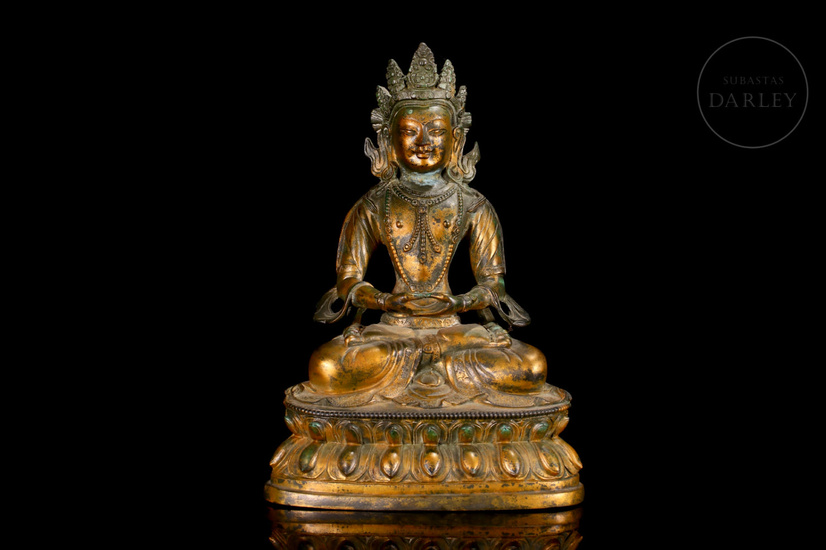Bronze Amitayus Buddha, Tibet, Qing dynasty, 19th century
Bronze Amitayus Buddha, Tibet, Qing dynasty, 19th century
A finely cast mercury-gilt bronze figure of the Buddha Amitayus, seated in meditation, on a double lotiform base with a pearled rim or beads in dhyanasana. The lower part is engraved with the Vajrayana symbol in the form of a cross, the blades of which are in the form of dorje or lotuses, a symbol of enlightenment.
With her hands in her lap, elaborately dressed in robes draped over her shoulders and in folds around her knees with a windswept ribbon, ornaments in the form of necklaces, bangles, bracelets and large earrings foliated in the shape of a disc, and on her beautiful face, a finely detailed tiara and a headdress of five conical details decorated with flowers. Her hair is completely tied back in a finely combed triple bun supporting the headdress and tiara. His face in a serene expression with arched, incised eyebrows, low but large eyes, aquiline nose and arched lips in a gentle smile, with the usual slight losses in gilding.
These depictions of the Buddha Amitayus are characteristic of the imagery used by Tibetan Buddhism. Emperor Yongle was a devout Buddhist who patronized Buddhist monasteries, art workshops and encouraged a cultural exchange between Tibet and China; as a result, Tibetan-Chinese style artworks depicting Buddhist deities executed with a high level of technical mastery began to be produced. Gilt bronzes were commissioned for personal religious practices and as gifts for the many Tibetan emissaries invited to the court. Qing Dynasty (1644–1912) 19th century.
Size: 21 x 9.5 x 14 cm
Weight: 2120 gr
References:
- Christie's. Indian and Southeast Asian Art. (21 MAR 2001) Lot 89.
- Drouot. ARTS D'ASIE & ARTISTES VO. Lot. 211
View it on
Sale price
Estimate
Time, Location
Auction House
Bronze Amitayus Buddha, Tibet, Qing dynasty, 19th century
A finely cast mercury-gilt bronze figure of the Buddha Amitayus, seated in meditation, on a double lotiform base with a pearled rim or beads in dhyanasana. The lower part is engraved with the Vajrayana symbol in the form of a cross, the blades of which are in the form of dorje or lotuses, a symbol of enlightenment.
With her hands in her lap, elaborately dressed in robes draped over her shoulders and in folds around her knees with a windswept ribbon, ornaments in the form of necklaces, bangles, bracelets and large earrings foliated in the shape of a disc, and on her beautiful face, a finely detailed tiara and a headdress of five conical details decorated with flowers. Her hair is completely tied back in a finely combed triple bun supporting the headdress and tiara. His face in a serene expression with arched, incised eyebrows, low but large eyes, aquiline nose and arched lips in a gentle smile, with the usual slight losses in gilding.
These depictions of the Buddha Amitayus are characteristic of the imagery used by Tibetan Buddhism. Emperor Yongle was a devout Buddhist who patronized Buddhist monasteries, art workshops and encouraged a cultural exchange between Tibet and China; as a result, Tibetan-Chinese style artworks depicting Buddhist deities executed with a high level of technical mastery began to be produced. Gilt bronzes were commissioned for personal religious practices and as gifts for the many Tibetan emissaries invited to the court. Qing Dynasty (1644–1912) 19th century.
Size: 21 x 9.5 x 14 cm
Weight: 2120 gr
References:
- Christie's. Indian and Southeast Asian Art. (21 MAR 2001) Lot 89.
- Drouot. ARTS D'ASIE & ARTISTES VO. Lot. 211



